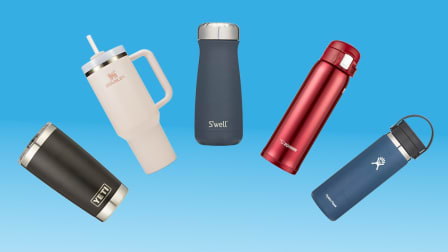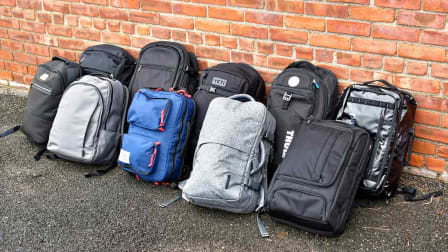CR's Guide to Hassle-Free Flying
How to pay less, wait less—and mostly, stress less—the next time you have to get on a plane

Once upon a time, airline travel was exciting and exotic. Today it’s more of an endurance test. "Unruly passenger" incidents—defined by the Federal Aviation Administration as passengers disrupting flights with threatening or violent behavior—jumped to 5,973 in 2021, up 492 percent from a year earlier. Marry that with crowded planes, cramped seats, confusing rules on fees for bags and seat selection, inadequate staffing, outdated infrastructure, and high prices, and it’s no wonder that flying is so trying.
But there are ways to minimize the pain. Start by checking our airline ratings. Based on our 2023 survey of 17,260 CR members and their experiences on nearly 33,000 flights, consider Hawaiian Airlines if it flies your route. Economy class passengers gave it top marks for check-in ease and on-time performance, as well as for cabin cleanliness and service. Budget carriers Spirit and Frontier got the lowest scores, especially when it came to price transparency and seat selection. (JetBlue and Spirit are awaiting merger approval.) Hawaiian and Alaska Airlines each earned a thumbs-up from business and first-class passengers.
Read on for other tips to improve your next flight.
It All Starts With the Flight You Book
Check Prices a Few Months in Advance
For domestic trips, Zach Griff, senior reporter at The Points Guy travel website, recommends starting to monitor prices three to four months before your departure date.
To begin your search, he recommends the Google Flights website. "They have an awesome price history and prediction tool." It gives you the amount your route has cost over the last couple of months, has a price graph that predicts what prices will be for nearly a year in advance, and tells you what Google thinks is a fair price today. It will also let you set up a price alert to get emails when prices change. However, it won’t include prices on Southwest flights, because that airline lists fares only on its own site.
Remember that the fare prices you see don’t include the extra fees you may pay to check bags, get a seat upgrade, and more. You can use tools like the bags filter in Google Flights to see the cost of your flight plus fees.

Photo: Alexandru Sava/Getty Images Photo: Alexandru Sava/Getty Images
The New Airplane Etiquette Rules
Learn how to be a polite passenger and defuse conflicts if and when they arise.
Stress Less at the Airport
Time Your Arrival Right
For domestic flights, plan to arrive at least 90 minutes early, says Griff of The Points Guy. If it’s a busy time at the airport—midday, Thursday through Monday, or during holiday or summer travel season—2 hours is safer. For international flights, arrive at least 2 hours before departure, and 3 hours during busy times.
Expedite the Security Process, for a Fee
If you’re a frequent flyer, consider joining a program that cuts your time in security lines. TSA PreCheck gives you access to an expedited security line, plus there’s no need to remove shoes, belts, light jackets, laptops, or 3-1-1 compliant liquids. It costs $78 for a five-year membership. In June 2023, 88 percent of PreCheck passengers waited less than 5 minutes, according to its website. You must fly with an airline that participates in PreCheck—more than 85 do—and more than 200 airports across the country have dedicated PreCheck lanes.
CLEAR Plus is an expedited airport security service that allows its members to verify their identity using biometrics without having to show a physical form of identification to a TSA agent. Once your identity has been verified at a CLEAR kiosk, you’re escorted to the front of the security line. The sweet spot of zipping through airport security fast is when you use both of these services together. With a CLEAR membership, you can quickly verify your identity and then go to the front of the PreCheck line. A CLEAR membership costs $189 annually; you can add up to three family members for $70 each per year, though family members under age 18 can use the CLEAR lane without a membership when traveling with their parents. CLEAR is available only at about 50 domestic airports, but it can also be used at stadiums and arenas that require lining up for a security check. Several frequent flyer programs and some credit cards offer cardholders discounts on a CLEAR membership, including many co-branded airline cards and the Green American Express card.
If you travel internationally, Global Entry includes PreCheck, and it provides expedited service through U.S. customs and immigration. The fee is $100 for a five-year membership.

Photo: Oscar Wong/Getty Images Photo: Oscar Wong/Getty Images
Make Waiting Worthwhile
If you have time to kill in the airport, plan ahead by downloading movies or shows to watch, or podcasts to listen to, or by bringing a book or eReader, says journalist Wilson. "If it’s a long layover in a larger airport, there are pay lounges you can go to. I have indulged in these, especially during long flight delays," she says. "Many airlines will allow you to buy a lounge day pass, and you can do it right on their app." For example, American’s Admirals Club and United Club offer one-day passes at some of their locations for $59. (Delta doesn’t offer a one-day pass.)
If you travel frequently, you might want to consider a network that offers access to lounges. For example, Priority Pass provides access to more than 1,300 lounges across the world. The cost for Priority Pass’ least expensive membership is $69 per year plus $35 each time you enter a lounge.
LoungeBuddy doesn’t charge a membership fee; customers can use its app to buy lounge passes at more than 300 lounges. Day passes cost $27 to $54 each, depending on the lounge. If you have a travel credit card with a hefty annual fee, it might provide lounge access; for example, the Citi/AAdvantage Executive credit card includes access to Admirals Club for you and two guests in its $595 annual fee. If you have the Delta SkyMiles Reserve Credit Card from American Express, $550 per year, you can use Delta Sky Club, which gives you two free one-time guest passes.
Also visit your airports’ websites to see whether there are any special amenities you might want to check out, says Griff. Chicago’s O’Hare and Midway international airports, as well as Burlington, Dallas-Fort Worth, Miami, and San Francisco international airports, have dedicated yoga rooms.
Dine Like the Locals
Check the websites of the airports you’ll be visiting ahead of time to check out their dining options. Airports across the U.S. have been giving passengers upgraded food options, and a big part of that includes bringing popular local eateries to their terminals, Wilson says. Some of her favs: Leah’s Kitchen in Louis Armstrong New Orleans International Airport for creations based on the late Leah Chase’s Creole cuisine; Driftwood, Texas, barbecue spot The Salt Lick has restaurants in the Austin and Dallas airports; and Chicago celebrity chef Rick Bayless of Frontera Grill fame has several Tortas Front locations at O’Hare. But you’ll probably pay a premium: Andrew Weddig, executive director of the Airport Restaurant & Retail Association, says many airport restaurants charge 10 percent more than the local "street price." The exception is BWI Airport in Baltimore, which charges street pricing in all its restaurants.
Learn the Carry-on Baggage Basics
Your carry-on bag will need to fit the size regulations of your airline, which you can find on its site. Most airlines implement a maximum size policy of 22x14x9 inches, including wheels and handles. Some airlines may charge for a carry-on bag if you fly its least expensive class; for example, JetBlue charges Basic Blue customers $65 for a carry-on bag (one personal item no larger than 17x13x8 inches is free).
Budget airlines have stricter carry-on policies. Allegiant allows only one 18x14x8-inch personal item; carry-on bag fees range from $10 to $75. Frontier also allows only one free personal item of the same size restriction, and carry-on bag fees range from $57 at the time of booking to $71 close to your travel date. Wilson has flown Spirit when the same route on Southwest is too pricey or when Southwest doesn’t fly her route. "To avoid fees, I take one bag that I use only for Spirit that’s the [width and length] of a laptop," she says.
Enjoy Your Air Time
Dress for Comfort
TravelPulse’s Bowman suggests wearing comfortable athletic shoes. "I see people running with flip-flops because they’re heading to the beach, but that’s not ideal if you have to get from one side of a large airport to the other to make a tight connection," he says. Wilson wears tennis shoes that slip on and off. She also suggests comfortable yoga pants or stretchy jeans—especially important in tight cabin spaces. "I wear Figs pants, which are like medical scrub pants that look professional, plus have lots of pockets for your cell phone, even my Kindle." She also suggests carrying a jacket, hoodie, or sweater that you can put on or take off to adjust to the plane’s temperature.

Photo: Hero Images Photo: Hero Images
Get Some ZZZ’s
Wilson brings an eye mask to block light from the windows. Neck pillows and noise-canceling headphones can also help you zone out and get some sleep.
Pack Carry-on Must-Haves
Wilson brings her own snacks on every flight, like granola bars, a sandwich or hummus and chips, or Brie and crackers. If you want to brush your teeth afterward, "I like Colgate Wisps, which are like mini travel toothbrushes," Bowman says. Other things to bring include tablets or phones loaded with enough downloaded programming to keep you entertained on your flight, plus compatible noise-canceling headphones so that you don’t have to rely on the airline’s seatback system. And, of course, don’t forget your chargers.
Include an empty water bottle in your carry-on that you can refill after going through security. That way you don’t have to rely on those tiny drinks from the beverage cart to get you through a multiple-hour flight. And pack small bottles of lotion, eye drops, or nasal spray if you’re worried about dry airplane air.
Editor’s Note: This article also appeared in the October 2023 issue of Consumer Reports magazine.





















